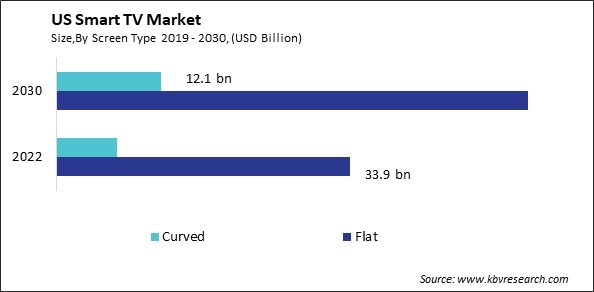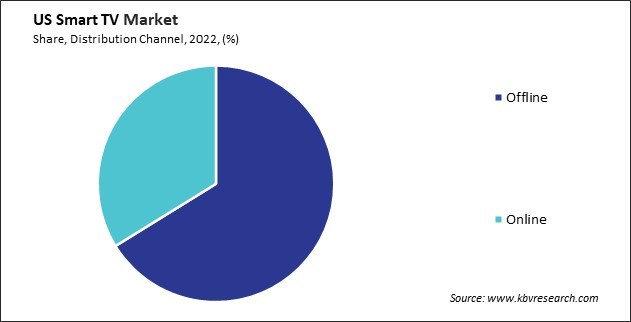Int'l : +1(646) 600-5072 | query@kbvresearch.com
Int'l : +1(646) 600-5072 | query@kbvresearch.com
Published Date : 16-Feb-2024 |
Pages: 106 |
Formats: PDF |
The USA Smart TV Market size is expected to reach $66.7 billion by 2030, rising at a market growth of 6.4% CAGR during the forecast period. In the year 2022, the market attained a volume of 63,670.6 thousand units, experiencing a growth of 6.7% (2019-2022).
The smart TV market in the United States has witnessed robust growth, driven by several key factors. The increasing adoption of Over-the-Top (OTT) services, including popular streaming platforms, has positioned smart TVs as the go-to entertainment product for consumers seeking seamless access to a diverse range of content. The convenience of built-in streaming capabilities, app ecosystems, and advanced features has made smart TVs a preferred choice among consumers looking for a comprehensive and integrated entertainment experience.

Media is changing due to streaming services like Google Chromecast, Amazon Fire TV, and Apple TV. Several manufacturers are collaborating with over-the-top content and device providers to offer integrated capabilities that eliminate the need for a set-top box. For example, TCL Corporation and Roku Inc. collaborated to launch a 4K HDR Roku TV.
Furthermore, as the availability of high-speed internet access has increased in recent years, so too has the viewership of online content. Additionally, as demand for smart devices, such as smart TVs, escalates, the technology sector has begun to combine various technological innovations, such as voice command and computational intelligence.
Over the past few years, there has been an ongoing rise in the adoption of smart TVs. In 2018, more than 37% of US homes owned at least one smart TV, increasing 16% from the year before. Two trends are responsible for this rise. Firstly, over-the-top video streaming services have gained popularity. Hulu and Netflix have more than 28 million and 60 million customers in the US, respectively. Secondly, smart TV solutions are reasonably cheap; built-in smart TVs are currently only a few hundred dollars, while many external smart TV boxes and sticks cost around $50. Consequently, many smart TV platforms have surfaced and been incorporated into different devices. For instance, TCL and Sharp TVs contain Roku, and Apple TV integrates tvOS.
The adoption of the 8K resolution in the United States has experienced significant growth in recent years. A key driver behind this surge is the gradual reduction in the prices of 8K TVs, making them more accessible to a broader audience of consumers. As the cost difference between 8K and lower resolutions diminished, consumers found the allure of enhanced visual quality increasingly compelling.
Furthermore, the availability of 8K content has played a pivotal role in driving adoption. Streaming services in the US, including Amazon Prime Video and Netflix, expanded their libraries to include 8K content, enticing viewers with sharper images and more vibrant colors.
Consumer preferences also shifted towards higher quality displays, with 8K resolution meeting the demand for greater clarity, sharpness, and detail in visual content. Television manufacturers capitalized on this trend by actively promoting the benefits of 8K technology in marketing campaigns, fostering awareness and interest among potential buyers.
Larger screen sizes, particularly those in the 55-inch and above range, gained popularity as the increased pixel density of 8K resolution became more noticeable on larger displays. Technological advancements like High Dynamic Range (HDR) and Wide Color Gamut (WCG) further complemented the 8K viewing experience, contributing to the overall appeal of upgrading to 8K TVs.
The gaming industry in the US also significantly promoted 8K adoption, as gaming consoles and high-end gaming PCs began to support 8K gaming. This attracted consumers seeking a more immersive gaming experience, adding another dimension to the demand for 8K-capable displays.
Samsung offers a wide range of 8K TVs in the United States to cater to consumer preferences and budgets. This includes entry-level models, mid-range options, and premium high-end TVs. Samsung's diverse product range allows it to reach a broad spectrum of consumers. The company invests significantly in marketing and advertising, promoting its 8K TVs through various channels. This helps create brand awareness and influences consumer decisions when purchasing a new TV. They also benefit from a robust global supply chain and distribution network. This enables the company to manufacture and distribute its products efficiently, ensuring the wide availability of Samsung 8K TVs in the industry.
The 8K smart TV market is anticipated to grow at a rapid rate. 8K TVs support over 33 million pixels and offer acceptable image resolution. The resolution's content library is constantly expanding as it becomes more prevalent in the industry. As more manufacturers provide features like high-dynamic range (HDR) and Dolby Atmos sound, the sector is predicted to expand rapidly.
OLED (Organic Light Emitting Diode) TVs are known for their superior picture quality, with individually lit pixels achieving accurate black levels and high contrast ratios. This results in vibrant colors and an impressive viewing experience. QLED (Quantum Dot LED) TVs enhance color accuracy and brightness. The quantum dots act as color filters, allowing for more precise and vibrant color reproduction.
Major TV manufacturers in the US, including LG, Panasonic, and Samsung, have heavily promoted and marketed their respective technologies. This has created awareness among consumers and influenced purchasing decisions.
While OLED TVs historically had a higher price point than other technologies, increased competition and advancements in manufacturing have led to more affordable OLED options. QLED TVs, a technology developed by Samsung, have also become competitive in pricing. OLED and QLED TVs have introduced gaming-focused features, including high refresh rates, low input lag, and support for variable refresh rate (VRR) technologies, catering to the growing gaming industry.
LG has been a prominent player in the OLED TV sector, and its OLED TVs have gained popularity in the United States. LG's OLED technology is known for its impressive picture quality, including deep blacks, vibrant colors, and high contrast ratios. The company's OLED TVs have been well-received by both consumers and critics.
Moreover, Panasonic recently launched the LZ2000 in the US in April 2022. With its superior TV series, updated Game Control Board settings, automatic NVIDIA GPU identification, enhanced 60Hz latency, and compatibility with HDMI2.1, the LZ2000 has been developed as a powerful gaming TV. Thus, the rise of such technologies will aid in the demand for smart TVs in this nation.

Intense competition exists among major players in the smart TV market of the United States, which accounts for a greater proportion of the landscape of rapidly evolving consumer electronics. Key competitors such as Samsung, LG Electronics Inc., Sony Corporation, Panasonic Corporation, Vizio, and TCL navigate a dynamic environment shaped by technological advancements, changing consumer preferences, and industry trends. These competitors distinguish themselves through diverse product portfolios spanning various screen sizes, display technologies, and additional features.
In the US, technological innovation remains a key battleground. Smart TV manufacturers in the US continuously invest in R&D to introduce cutting-edge features like AI integration, voice control, and gaming capabilities. Assessing the technological advancements of each competitor provides insights into their commitment to staying at the forefront of the industry.
In 2022, Best Buy emerged as a critical driver in the flourishing smart TV market in the United States, leveraging its local sector to propel growth and enhance consumer adoption. With an extensive network of stores strategically positioned across the country, Best Buy became a crucial catalyst in shaping the trajectory of the smart TV landscape. Best Buy's local industry went beyond conventional retail by providing comprehensive services that streamlined the adoption of smart TVs. This included professional installation services, technical support, and strategic product bundling, ensuring customers purchased smart TVs and seamlessly integrated them into their homes.
By Screen Type
By Distribution Channel
By Resolution
By Screen Size